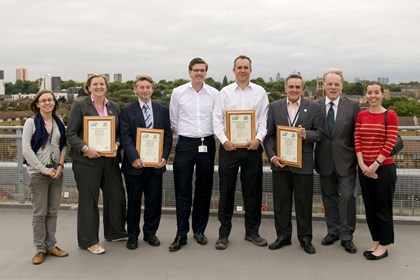CEEQUAL rating of Excellent for multi-storey car park at Olympic Park
Overview

Commissioned by The Olympic Delivery Authority, the design and construction process for the car park had to meet the high standards for sustainability. Scoring 93.3%, the project achieved an Excellent rating under CEEQUAL Version 4, now known as BREEAM Infrastructure.
About

The Olympic Delivery Authority was established by the London Olympic Games and Paralympic Games Act, which received Royal Assent in March 2006. The Act was passed to ensure the necessary planning and preparation for the Games could take place. As a public body, the ODA is accountable to government, the Greater London Authority (GLA) and other stakeholders for its work.
Background
During the Olympic Games, the multi-storey car park was to act as entry-control for international press with in-built ID check and security screening on the 1st floor, with a link bridge to the IBC building. The ground level needed to be designed for coaches with safe drop off zones and coach parking. Upper floors were intended for cars with accessible parking adjacent to the entry suite.
In legacy mode, there are plans to modify the structure, removing the western half of the car park, fitting permanent cladding and a large array of photovoltaic panels at roof level. This is in accordance with the Olympic Legacy strategy for renewable energy. The main structure has been designed from prefabricated components to ease dis-assembly. The footprint of the western half will be designated for community orientated use after the Games.
Challenges
The site allocated for the media Hub and car park within the Olympic Master Plan suffered from ground contamination and presence of ground gases, common with other areas of the Park. Extensive ground remediation works were carried out across the Park with a “soil hospital” where contaminated subsoil and topsoil were collected, treated and recycled. A gas membrane and subsoil contamination monitoring points had to be incorporated.
In common with all Olympic projects, the ODA set exacting standards for sustainability for the design, construction and operational stages. There was a strict monitoring and reporting regime of key performance indicators throughout the construction phase.
Solutions
Initial designs were developed by Walsh Associates on the site for the portal designated by ODA as part of the Park strategy. Following outline planning clearance for the concept, Byrne Brothers Ltd (specialist concrete structure contractors) were appointed under a design and build contract.
The robust ODA park-wide sustainability targets were enforced through contract requirements with regular reporting and audits. The site was adjacent to local housing to the west. Extensive stakeholder consultation and attention to visual impacts and adoption of CFA piling and off site prefabrication of the structure significantly reduced nuisance to neighbours.
Ground contamination in the substrate gave rise to the installation of a gas membrane under the structure and incorporation of ground water monitoring points within the site. The adjacent canal was a sensitive receptor and monitoring continued throughout construction and post completion.
Benefits
All waste material was recycled through the Olympic Park on-site recycling centre. The MSCP achieved 98% recycling of site waste. Off site prefabrication techniques reducing waste and construction time, and enabled “deconstructability” after the Games and at the end of service life.
Materials used to construct the MSCP incorporated 21% recycled material content and 100% of bulk fill and sub-base were sourced from recycled or reused material. The groundworks included on-site lime stabilisation of existing soil to reduce bulk fill movements. Considerable savings in materials and embedded carbon were achieved by the prefabricated design. The design also needed to address the client requirement to demolish 50% of the structure in legacy-mode.
The structure’s post occupation energy use is limited to lighting, which has high efficiency luminaires and daylight sensor switching control. Photovoltaic panels are to be installed on the roof after the Games as part of ODA’s Games and Legacy sustainable energy strategy.
